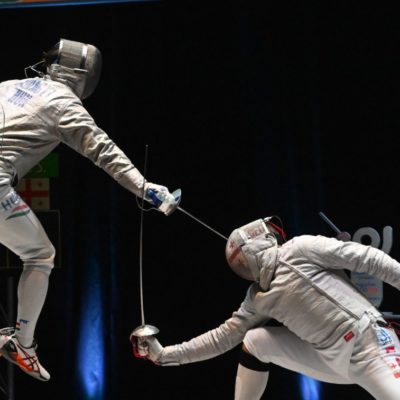View this sample from the Foil Actions CD-ROM available in the Fencing.Net store. In this clip, Walter analyzes the tactical situation of “doubling out” in foil. The video clip in this is 3MB.
You can purchase the Foil Actions CD-ROM at the Fencing.Net Store.
 |  | |
Attack from right, touch. |
There are three actions in this clip. The actions are connected to each other by a tactical continuity that exists in both fencers’ minds. This is the doubling-out schema, sometimes called "1-2-3" or "1-2-Bing!" Depending on how bright the fencers are, it can also be something like "1-2-3-4-5-bing." Here’s how it works. The series begins with the two fencers making simultaneous attacks, often with an identical advance-lunge rhythm. Without much of a pause, the director puts them on guard, and they are at the same distance as the previous action. They also have the same mood as before (attacky). The second action looks quite like the first action. Simultaneous again, on guard, same distance. By the third action, one or both of the fencers have awakened to the fact that their opponent is being predictable, and they change their strategy. When you know your opponent is going to make an advance lunge attack, there are many things you can do. You can go faster than them and hit first, you can invite and then parry, you can stop-hit and flee, you can play it safe and earn another simultaneous call from the director. These fencers are high level competitors. They perceive the doubling-out from the first action. Both of them want to own the next action, but (whups!) they both decide to make a parry. The second action is also judged simultaneous by the director. They enter the third action. For the third action, the fencers each make a different choice. Fencer left decides to search for a parry. Fencer right decides on a double-fast attack, and scores. Doubling-out schemes like this are really just complicated version of Rocks, Paper, Scissors. Both players have gone Rock-Rock, Scissor-Scissor. For the third throw, their eyes meet — each knows that the other is going to try something clever. What to choose, what to choose? Both fencer knows it’s mostly safe to throw Rock again, so maybe one will chose Paper… in which case, the one who does Scissors will cut the Paper. In this action, fencer right chose Rock again, so to speak: second-intention reverse-psychology. It’s fascinating, but maddening, to parse all the variations of a doubling-out series. The best thing is to merely understand that doubling-out exists, and that it’s a game within a game. Once fencers start looking for it, they are surprised to see how often this sort of thing occurs. Lastly, fencer right is being smarter, overall. Though he is stuck at the end of his strip, he has locked his opponent into a repetitive, predictable pattern. He’s suffering from none of the psychological or tactical down-sides of having no room to maneouver. (From the 2003 World Championships Men’s Individual Finals.) |





